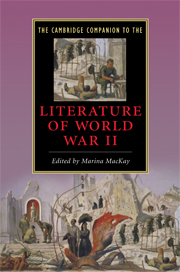11 - War writing in Australia, Canada, and New Zealand
from Part II - Global perspectives
Published online by Cambridge University Press: 28 May 2009
Summary
Even though the 1931 Statute of Westminster had made Australia, Canada, and New Zealand independent nations with autonomous foreign policies, New Zealand and Australia nevertheless responded to the outbreak of the Second World War as if they were still colonies, automatically at war as they had been in 1914. Both relied upon Britain for strategic imperatives such as security and defence, as well as for economic reasons. Further, sentimental links between Britain and its former colonies meant many continued to call Britain “home” and to regard the British as their “kith and kin.” Within hours of Britain's declaration of war on Germany, both New Zealand's Prime Minister, Michael Joseph Savage, and Australia's Prime Minister, Robert Menzies, rushed to offer the British government their support because they believed it inconceivable to do otherwise. In Canada, although the Anglophile, imperialist, and monarchist Prime Minister, Mackenzie King, was in favor of supporting Britain once war was declared, he knew he had to satisfy Francophone Quebec's concerns about the conscription issue that had proved so divisive in the First World War; thus he informed the nation he would “let Parliament decide.” After very little debate, Canada, too, was at war by September 10. As news of the defeats suffered by Britain and France continued to be reported in the press, the conscription issue was once again raised, but King's ambiguous proclamation, “Conscription if necessary, but not necessarily conscription,” served only to anger French Canadians.
- Type
- Chapter
- Information
- The Cambridge Companion to the Literature of World War II , pp. 149 - 162Publisher: Cambridge University PressPrint publication year: 2009



